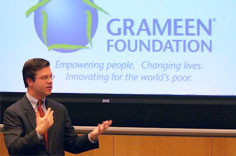Almost everyone wants to help the poor. In a world where many demand profits of 10%, 20%, 30% or more on their money, people donate to the poor despite a return of “negative 100%,” said Alex Counts, president and chief executive of the Grameen Foundation, which is dedicated to lifting people out of poverty by lending them money so that they can start small businesses.
Few people seem to consider the middle path pioneered by Grameen Bank, an institution that revolutionized methods of dealing with poverty through lending to the poor. Loans from Grameen Bank help people, most of them Bangladeshi women, to buy animals, open food stands and purchase phones that owners can rent out to generate profits. Why do most anti-poverty programs emphasize charitable giving over help to entrepreneurs? One reason, Counts said, is that people of relative privilege assume that the poor aren’t educated or experienced enough to succeed in business.
Counts, speaking recently as part of the Coleman Social Impact Lecture Series, urged the audience to reconsider their notions of the poor as incapable of starting and running a business. Living on $1 or $2 a day hones persistence, creativity and thrift, the very skills that make for a good entrepreneur, Counts said. “Those of us who have grown up in affluence underestimate the abilities of the poor and what is learned in survival mode,” he said, adding that he has never seen a “Help Wanted” ad in the world’s poorest villages. The poor work for themselves or not at all.
Counts often tells this story about Grameen Bank’s experience in the cell-phone business: When founder Muhammad Yunus wanted to help women in small, poor villages in Bangladesh start businesses by lending them money to buy cell phones so that they could charge neighbors to use them, several people told him it wouldn’t work. Such women were too poorly educated to learn to use a cell-phone quickly, the thinking went. Yunus launched the project anyway and then checked in on the women. He asked one how long it had taken her to figure out how to use the phone. “You must own a very complicated phone,” the woman told him. “My phone only has 10 numbers. I was in business in about 10 minutes. Professor Yunus, you should get one of these phones.”
Grameen Bank has been profitable since 1983, but it does not follow the standard advice of charging what the market will bear, according to Counts. “Professor Yunus said that when you lend to the poor, what you should try to do is recover your costs.”
Learning in the Field
Counts learned about microfinance from Yunus, who started what became Grameen Bank in 1976, believing that small loans to the world’s poorest residents could lift them out of poverty. The bank inspired the Grameen Foundation, founded by Counts in 1997 with $6,000 in seed funding. The foundation and the bank are separate entities; the foundation supports a network of microfinance institutions with educational programs, capital and technology support. Grameen Bank spawned a host of similar programs that lend small amounts of money to poor people to start businesses, including selling crafts, food and services. Its loans have helped borrowers buy everything from goats in Bangladesh to hair dryers for salons in Queens, N.Y. The bank’s customers borrow about $100 million monthly and pay it all back 99% of the time.
Counts deepened his study of microfinance by talking to thousands of borrowers. As a student at Cornell, he took Yunus’ advice and learned Bengali so that he could better understand the culture and the people.
After graduating with a degree in economics in 1988, Counts was a Fulbright scholar in Bangladesh, where he went to work for Grameen Bank. He later served as the legislative director of RESULTS, an international grassroots anti-hunger campaign, and was regional manager for CARE-Bangladesh for two years. Those experiences showed him that success comes slowly, sometimes over more than one generation. “There are very few overnight successes, very few people who start a business and six months later are out of poverty. But we do see standards of living slowly but surely rising for those touched by microfinance.” Numerous studies, available on the Grameen Foundation web site, support that assertion.
Despite widespread praise for Grameen and for microfinance in general, Counts said the field is in its infancy. “I’ve heard people say, ‘The innovation frontier in microfinance has closed,'” Counts said.
“Microfinance has come a very long way, but it’s got a long way to go.” Several years ago, a business professor told students that half of what they would learn in school was wrong, but no one knew which half. Compared to what is taught in business schools, the field of microfinance is relatively young, Counts said. “I can assure you that about two thirds of what we believe is best practice is wrong,” he said, “because microfinance is only decades old.”
High Interest Rates
Despite increasing competition in microfinance, “the price of credit is much too high. Rates of 40% to 50% are common, if expressed as an annual percentage rate,” Counts said, adding that although those rates still beat other types of small loans available to the poor, the microfinance industry must bring rates down further. Another problem: Each institution operates on its own technology, aggravating communication between microfinance organizations. “It’s as if everyone is saying, ‘We need to create our own word processing program,'” Counts said. Micro-lenders also need uniform ways to measure profits. “We’ve got a long way to go in terms of actually measuring the true bottom-line nature of microfinance. Everybody used to say they were profitable, but they would use any measure they could come up with.” Uniform statistics also could paint a clearer picture of whether micro loans are reducing poverty, and by how much. In addition, the industry has barely begun to consider its environmental impact.
He compared the industry’s status to that of the Internet in its early days. As people developed new ways of using the Internet, it grew in unpredictable and profitable ways. “This infrastructure to leverage microfinance is actually something much, much bigger than that. It represents the biggest intentional motivation of the poor in the world’s history.” He predicted that decades from now, people will look back at the current microfinance system and see it as “absurdly slow,” just as they now consider dial-up Internet access outdated.
Counts said Grameen Shakti, a bank spin-off that is selling solar-power systems to Bangladesh’s rural poor, has capitalized on the microfinance model in an innovative way. Grameen Shakti trains and employs women as technicians to maintain the systems. Initially, the energy company’s founders thought they would be doing well if they installed 100 solar systems. Now 10 years old, Grameen Shakti installs several thousand systems a month. Among other benefits, the solar power reduces indoor air pollution and allows children to study at night. Grameen Shakti, like the bank, succeeded because of the ingenuity of poor villagers. “The people who run Grameen Shakti, they are not engineers. They’re not even bankers,” Counts said.
Pay for Health Care ‘When I’m Well?’
Successful microfinance often requires experimenting with business models. When Grameen Bank tried to offer health insurance to the poor for a small yearly fee plus a co-pay for doctor visits, “The poor weren’t too happy. They said, ‘Why do I have to pay for it when I’m well?’ But then we said, ‘Okay, you have savings accounts. What if we just deduct $3 a month?'” The switch got enough people to buy the insurance, and the program is now recovering almost all of its costs. Grameen’s experience is consistent with economic research showing that people are more likely to spend when companies eliminate the physical handing over of the cash, Counts said.
In addition to helping poor people earn money, Grameen Bank turns them into owners. The bank’s borrowers have nine of the 13 seats on its board of directors, and every borrower is a shareholder. This creates immense pride, Counts said. One borrower-shareholder who sat on the board of the bank described herself as a Nobel laureate after Yunus and the bank won that prize in 2006 for starting Grameen.
More than 90% of Grameen borrowers are women. When Yunus started the bank, he thought about half the borrowers should be women, to reflect their numbers in society. But over time, he noticed that women paid him back more consistently than men and that women tended to plow their earnings back into their families. Loans to women were more likely to eradicate poverty, which prompted the bank to seek them out as customers. That emphasis also has raised women’s status in society. Bangladeshi women live under the threat of divorce; when their marriages fail, they usually have to return to their parents and can’t remarry. But to get a loan, said Counts, the woman often must have some property in her name. Once a woman has property rights, “you can imagine that that changed some of the dynamics in the house.”



